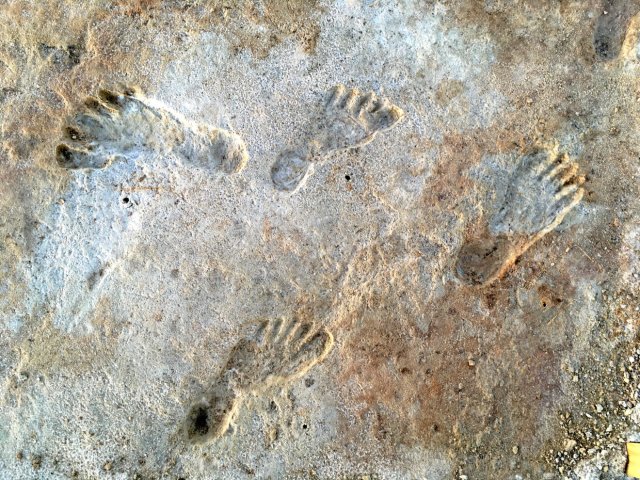The gypsum dunes of White National Park preserved Ice Age footprints.
Foto: National Park Service
Traces in the sand are generally very transient. However, it is different when, in rare cases, the surface consists of gypsum dunes, such as in the American White Sands National Park. Here, around 22,000 years ago, a young woman with a small child in her arms ran frightened through the damp dunes to escape from wild animals. Their prints in the sand were preserved, leaving not only physical traces on site, but also traces in history that challenge common understandings of the settlement of the Americas.
A woman on the run
Footprints of people and animals from the last Ice Age were discovered in the national park in 2009, but the breakthrough only came in 2018, when researchers from the US Geological Survey discovered the young woman’s tracks, which they were able to trace for over 1.5 kilometers. The researchers initially noticed a long series of regular, dark spots. An initial excavation uncovered human footprints, which were later followed up. They also came across tracks of mammoths and giant sloths that crossed human tracks or were crossed by those of the woman. Therefore, we know that the person felt threatened by these animals. Analysis of the stride length, the size of the prints and how the person slipped in the wet sand revealed that it was a teenager or a young woman who alternately carried a small child on their hips. Every now and then she would put the child down and walk along for a few steps, then pick him up again on the other side. Of course, you can’t determine a person’s gender from footprints, but here the researchers drew parallels to historical hunter-gatherer groups where only women carried children in this way. The footprints ran along a now dry lake and the animals may have felt disturbed by the young woman, which is why they appeared threatening and caused her to flee.
Doubts about first dating
The research group published a first study in 2021, in which they settled on an age between 21,000 and 23,000 years. To determine the age using the radiocarbon (C14) method, they used aquatic plants that grew under and around the tracks were found. This dating caused criticism because aquatic plants can absorb carbon from groundwater and thus show an older age than their own. That’s why the scientists analyzed two other data sets in recent years, both of which produced approximately the same results. They examined pine pollen and seeds found in the same layers and compared their C14 results. Both measurements gave an age between 23,400 and 22,600 years. Collecting the pollen was a laborious task, as at least 75,000 were required as a sufficient amount of biological material for dating. In parallel, quartz grains immediately beneath the footprints were examined using optically stimulated luminescence dating. This method measured when the grains were last exposed to sunlight and determined a minimum age of 21,500 years. This means that there are measurement results from three different analyzes that point in the same direction: people were in North America at least 8,000 years earlier than previously assumed and, above all, proven.
nd.Kompakt – our daily newsletter

Our daily newsletter nd.Compact brings order to the news madness. Every day you will receive an overview of the most exciting stories from the world editorial staff. Get your free subscription here.
It has been scientifically proven that America has been inhabited for around 14,500 years, including by determining the age of the skeleton of the so-called Anzick child in Montana and a discovery of human excrement in Paisley Cave in Oregon. The Anzick burial and other finds belong to the Clovis culture. Scientifically controversial finds in eastern North America, Texas and northern Mexico suggest that the immigration occurred earlier than 20,000 years ago and that the immigrants belonged to an as yet undefined pre-Clovis culture.
Temporal and geographical gap
The mystery of early immigration to America doesn’t get any easier when you include the Monte Verde site in Chile, which has a confirmed age of 14,500 years. There are also other sites, particularly in Brazil, that go back even further into history, but where the uncertainties are even greater than with their North American counterparts. Since immigration took place via Beringia, the lost land bridge between Asia and Alaska, there is a huge gap in time and geography because the immigrants first had to move along the west coast of North, Central and South America and cross the Rocky Mountains and Andes.
This is why the footprints in the sands of New Mexico are so important, because they support the theory of immigration to America 20 to 30,000 years ago. Without finds of skeletal parts and cultural relics, even the best footprints only lead into the dark and times of immigration and genetic relationships with indigenous people living today remain mysterious.
#ndstays – Get active and order a promotional package

Regardless of whether it is pubs, cafés, festivals or other meeting places – we want to become more visible and reach everyone who values independent journalism with an attitude. We have put together a campaign package with stickers, flyers, posters and buttons that you can use to get active and support your newspaper.
To the promotional package
sbobet link sbobet sbobet88 judi bola online
